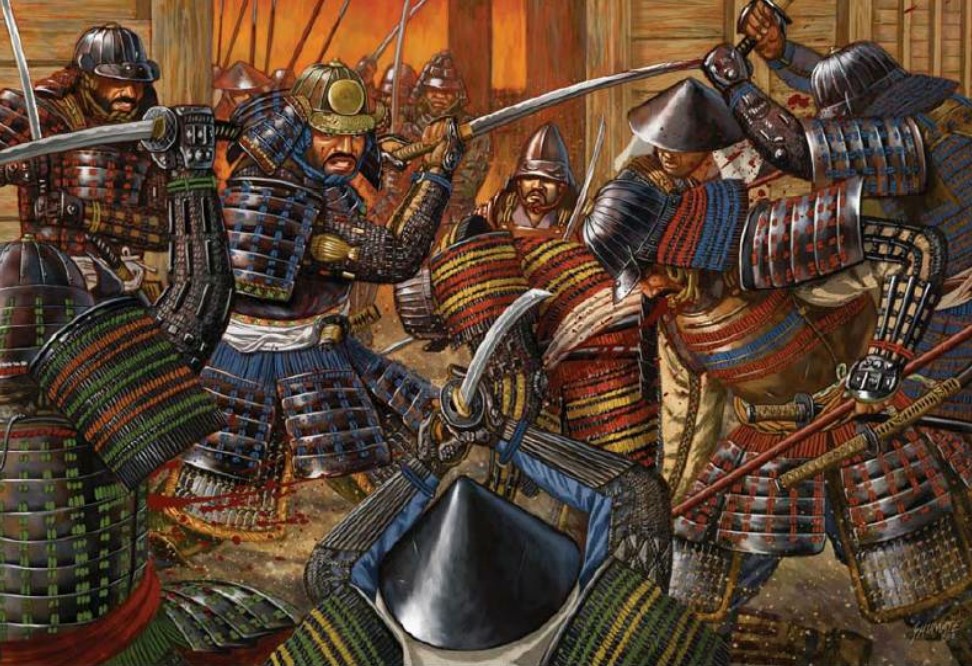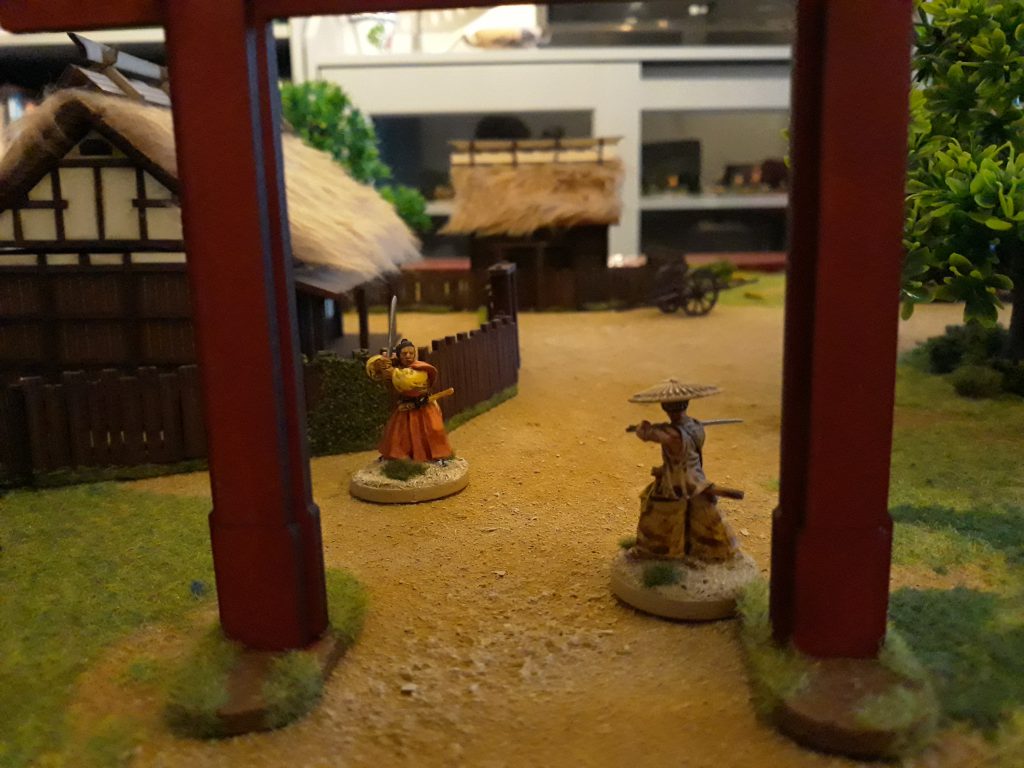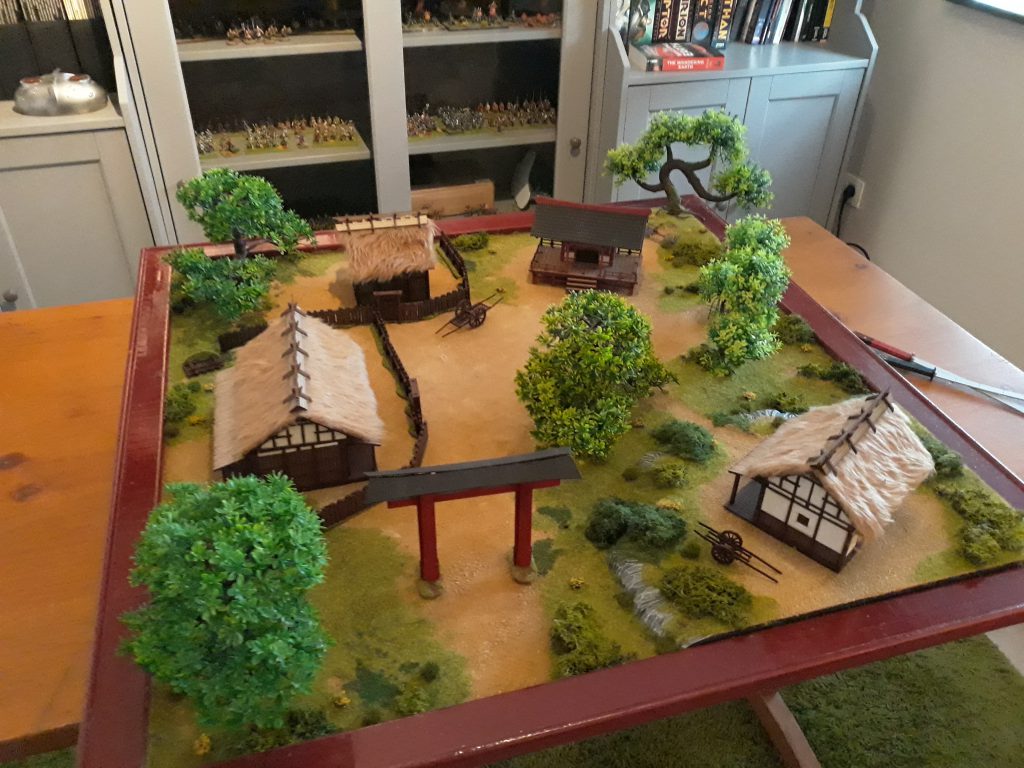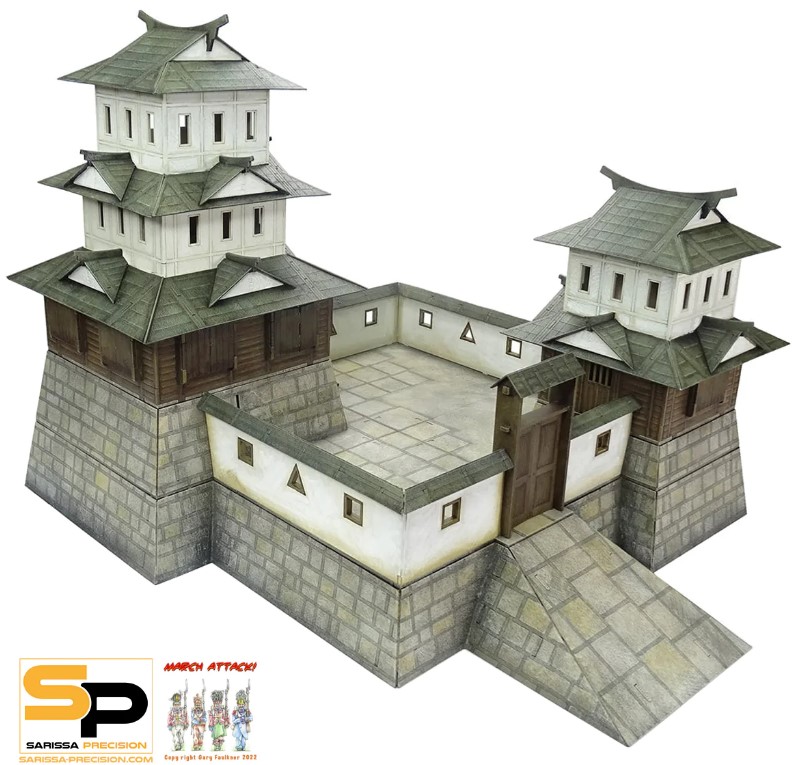In this week’s review we travel back to the 16th century, not for any pike wielding friends, but our road takes us to the conflicts further east. Written in 2013, Ronin is one of the first accessible rulesets that lets us use samurai and maybe even some ninja in a skirmish game. Expanded on in “En Garde”, its three musketeers adjacent prodigy, the book certainly doesn’t show its age yet and has some interesting mechanics to go crazy with a katana.

To be frank, it’s not like there are a whole bunch of rulesets that let you play a skirmish game that isn’t focused on western conflicts, certainly for the time period. Written by Craig Woodfield, it is rather light on background. Only a few pages are dedicated to the setting this is mostly used for (late Sengoku), and some descriptions of the most common weapons and armor. Later Osprey titles add a little more to these sections, and it would certainly be welcome to get a little bit more background, especially for newer players who are drawn in by the rattle of a katana in its scabbard. If you get to the list building there are some paragraphs detailing the basics of the different factions as well. Getting a bit ahead of myself, it’s nice options to build a Korean or Ming Chinese are included, as well as peasants or a koryu, so your model collecting doesn’t have to stop at your classic samurai miniatures.

That neatly leads me to the next point. To get started with Ronin, you’ll need between 4-20 models, a playing area of at least 2×2, dice, something to measure stuff, and some tokens in different colors. The bar for entry is pretty low, as most wargamers will have tokens, dice and rulers galore, and some woodland scenery as well to get started. The board size can differ, either by going smaller and very specific, or bulking out the warbands and creating elaborate scenarios. I think 3×3 is big enough for larger games, and the book recommends a 4×4 only for larger buntai or specialized scenarios. Here’s why:
Its’ sandbox time again! Well more or less. But this ruleset once again gives you the freedom to tinker away at your own scenarios and leaves plenty of leeway to make a custom warband, without the usual pitfalls this entails (an ambiguously written ruleset where you have to houserule stuff every 5 minutes). Simple but tight, the gameplay moves fast and is beginner friendly. The charm and hook offered here lies in the combat.

The game turn is divvied up into 5 phases. The first step to see who gets a go is in the Priority Phase. Every player rolls a D6, the winner has the first activation and gets to choose which combats resolve first. After that, players check the morale of their buntai, and see if anyone books it off the table. Morale is a factor in this game, and you can be defeated by losing too many followers or getting owned in general.
If still on the table, the player with priority chooses and moves their first model. Like most games, there are penalties if you’re crossing difficult terrain, have to carry an objective around or want to retreat from combat. Unlike most games, you can also use a missile weapon here. This is treated as a hurried or on-the-fly shot, and is less accurate, but can be used as a way to get some early fire in and harry the opposition. This also means you can shoot twice with weapons that don’t have to be reloaded, which usually means a bow of some sort.
The next phase brings the meat of the game, combat! The hook I’m talking about is the use of tokens to resolve this. Every model has a CP or Combat Pool rating, which indicates how many tokens they add to the total combat pool of their side. Combat usually involves fighting multiple opponents, and all models in base to base combat fight. Practically the different clashes are divided up, as it can get complicated otherwise.
The player with priority picks the first model to resolve combat, and the total CP of ALL fighters engaged in that engagement is counted up. The defender does the same. Then you choose which of these tokens will be used for attack, and which ones for defense. Tokens can be used to enhance rolls: add an extra die to roll off, either in the initiative roll to see who strikes first (even if you’ve got priority a full-fledged samurai can outclass a peasant) or in the attack or defense rolls. Then, the combat is resolved. Pick out a model to attack, remove an attack token from your CP, choose to enhance the roll or not (removing another token), and roll the appropriate dice. The fight characteristic is added to the rolls and then the result of the rolls is subtracted from each other. Time to look at the wound table and see if your warrior has any new orifices! This is quite confusing to explain in text so let’s use an example here.
I’ve got priority and decide to activate my samurai. He has a fight value of 3 (average), a CP of 3 and medium armor. He’s fighting two bandits, one with a fight value of 2 and CP of 2, the other (a peasant) having attack 1 and CP 1 bringing their total pool to 3 for this engagement. I decide to go all-in with three attack counters, my opponent chooses a sensible 1 attack and 2 defense.
We roll off for initiative, and I enhance my roll by spending an attack token. I roll a 10 on 2D6, my opponent rolls a 3 for bandit number one and a 6 for bandit peasant number two. This is the order in which combat will proceed. Since I go first I attack the bandit, ignoring the peasant and hoping to take out the bigger threat. Using my remaining last token I enhance my attack roll, hoping to do some serious beheading. My opponent uses one defense token to enhance their roll, hoping to survive the vicious attack. Rolling nice 10, I add my fight value of 3, bringing the total to 13. The opposition fairs worse, having rolled a 5, and with no armor to benefit from, only adds the fight value of 2, resulting in a difference of 6 in my advantage. Consulting the wound table a difference of 6 or more means a critical wound, aka, a head rolls in the dirt. The fight isn’t done yet, as my opponent still has a bandit peasant which hasn’t activated, so the fight continues. Without any tokens left, I can only defend using one D6, so the peasant might get a lucky shot in…

Other stuff that influences your priority/attack/defense roll: being heavily armed, wearing lots of armor, getting stabbed in previous combat and bleeding all over the place. Some weapons give you a bonus on the initiative roll while being slightly worse in an actual attack. You can also try to subdue or disarm an opponent, which is a neat thing and comes in handy in certain scenarios. Combat flows fast and there aren’t that many stats to keep track of. Good and great fighters will generally prevail, but you will have to choose your battles carefully. Positioning and attacking does matter, so you can’t just charge in and be secure in victory.
After the hacking and slashing, there’s the Action Phase, where you do general stuff, like reloading, looting, collecting heads (yes), mounting or dismounting a smaller than average horse, getting a bit of rest, and you get a second chance to shoot if you’re able, without any drawbacks. If you’re not engaged in combat or gotten a bonk to the head leaving you stunned, you can choose any one action.
The End Phase: get rid of pesky stunned counters and see if you’ve won!
That’s it. The fun of this ruleset is very much the simplicity and ease with which you can get a game going. This is reflected in the building of your warband. You will find stats for Bushi (classic samurai), who can reflect any clan you want, and have a good choice of weaponry. For our 40k playing readers, these are your space marines. Posterboys for the period, solid stats and lots of lore to choose from. On the other hand, if you want to game a peasant uprising, you can swarm the board with models wielding improvised weapons. There’s also room to further customize your warband: every buntai has some special rules. Your warrior monks often carry a banner into battle, which gives a bonus. Samurai can collect heads to gain extra points. On an individual level, you can use abilities and martial abilities (Bujutsu) as well. If you want a game where Musashi faces off alone against wandering Ronin, you can kit him out with weapons and abilities to emulate his legendary status.
Modelwise a few packs of the excellent Perry miniatures will be enough to set up some interesting games. Grey for now games, of Test of Honour fame, has been producing some killer packs as well that will set you up with a rounded out warband in one go. These are made by Footsore Miniatures and have a lot of character and dynamic poses. Warlord Games has some metal and plastic models, but keep in mind that those plastics are more suited for massed combat, as they’re more static. They’re a bit fiddly to assemble as well.

The appeal for me is that this is a system that gives you the opportunity to do a small project with some excellent models in an interesting setting. You can make a dedicated table with nice buildings, paint up 20 to 40 models and you’re pretty much done. Speaking of buildings and scenery: Sarissa Precision has a whole range of buildings to populate your table. You don’t have to make it a wilderness game. Most terrain makers have at least some buildings available either unpainted or pre-painted.

Another option you have is to throw the period out of the window and experiment with your own setting. With relatively few tweaks you can use this system to use vikings, crusaders, or any other comparable forces you might have in your collection. The robustness of the mechanics will give an enjoyable game. The fact it has a follow-up in an even more swashbuckling style with En Garde! is a testament to that.

Skirmish games are an excellent way to get a feel for the period without spending a ton of money on models in one go. You can see if you like painting something specific, explore the period without breaking the bank. Ronin is a game that will be a keeper in your collection, and it is an excellent standalone product even if you’re not going to game mass battles. For me this is a no-brainer. Another excellent ruleset from Osprey that deserves a bit of hype.
Have any questions or feedback? Drop us a note in the comments below or email us at contact@goonhammer.com.


